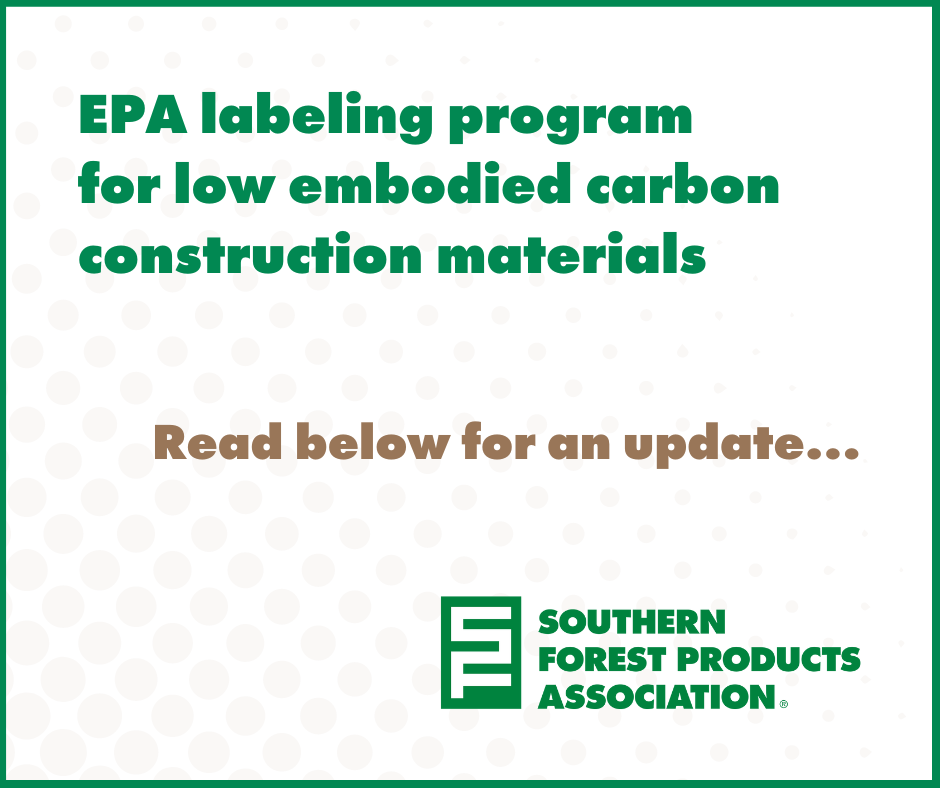The U.S. Environmental Protection Agency released a plan August 7 for implementing a new labeling program to boost clean American manufacturing by helping federal purchasers and other buyers find and buy cleaner, more climate-friendly construction materials and products.
The implementation approach for its label program for low embodied carbon construction materials outlines how materials and products that earn the label will be listed in a central, publicly accessible registry, making it easier to identify – and therefore purchase – these materials.
However, wood is not included in that list.
Label Program and EPD Background
The EPA announced 38 grant recipients July 16 for its Expanding Data and Enhancing Transparency of U.S. Wood Products program, including a grant award of $6 million to the American Wood Council and the Treated Wood Council, of which the Southern Forest Products Association helped start and continues to partner closely with.
While all the specifics of the grant have yet to be confirmed, TWC hopes to receive a large portion of its requested $1 million to update the Product Category Rule (PCR) for North American Pressure-Treated Wood Products and to initiate Environmental Product Declaration (EPD) work for various treated wood products.
TWC’s work will use other EPDs as base data for the construction of its cradle-to-gate EPDs while relying on AWC’s EPDs for untreated wood products.
Meanwhile, AWC released regional industry average EPDs for the U.S. wood products industry August 19.
Jeff Miller, president and executive director of the Treated Wood Council, has anticipated the Biden administration would use PCR and EPD data to swing federal purchasing toward construction materials that are more “environmentally friendly.”
However, Miller expressed disappointment that the EPA’s label program “still seems to focus on steel, concrete, glass, and asphalt, without mentioning the best ‘low carbon’ construction material – wood.
Showing Support for Wood
Wood construction materials make up 47% of all industrial materials in the U.S. but consume only 4% of the total energy to manufacture those materials. In contrast, manufacturing materials from aluminum, glass, plastic, cement, or brick, some of which are the subject of the first phase of labeling, can require as much as 126 times more energy than making them from wood.
In addition, wood products are about 50% carbon by weight and continue to store carbon for the life of the product, with many treated wood products providing a source of energy recovery following their primary use.
With that information, Miller wrote to the EPA that the program scope is limited, misleading, and misses the opportunity to promote environmentally friendlier construction materials. Click here to see the full letter.
The treated wood industry recognizes EPA’s goal of implementing programs to guide U.S. federal, state, and local government procurement policies, as well as large institutional procurement policies, aimed at driving down greenhouse gas (GHG) emissions related to construction materials.
That same industry has taken independent steps to disclose the embodied carbon of the materials and products produced, and has made available GHG emissions data associated with the extraction, production, transport, manufacturing, use, and disposition of these products.
“While the treated wood industry has no issue with EPA’s goal of first addressing these industry sectors, known to have high embodied GHG emissions, we continue to voice our concern that such narrow focus totally misses the opportunity to encourage government procurement offices to utilize construction materials, like wood, that are biogenically-created, inherently low embodied carbon construction materials with the added benefit of sequestering carbon during their use and beyond,” Miller said in his letter.
The treated wood industry supports EPA’s desire to improve data quality and make robust EPDs available, Miller said, adding that TWC also supports consistent standards and guidelines for modeling and accounting of GHG emissions.
He cautioned, though, that creating standards, such as the recently issued draft criteria for PCRs, adds unnecessary requirements to an already complex process.
